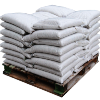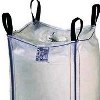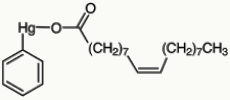| We offer Halal and Kosher Phenylmercuric Oleate or Phenyl Mercury Oleate manufactured in an ISO9001, ISO22000 (FSSC22000) and cGMP certified facility, Anmol Chemicals a mubygroup company involved in manufacturer of Speciality Chemicals, Pharmaceutical Excipients, etc. The group has several manufacturing facilities spread across the world, supported by toll manufacturers and representatives in UAE, Europe, USA & china. |
| The units in the group have one or more of the certifications like FDA GMP, ISO 9001, ISO 22000, HACCP, REACH, Kosher & Halal and DMF support is available. |




Phenylmercuric Oleate or Phenyl Mercury Oleate SDS GHS MSDS of Manufacturers

CAS Number: 104-60-9, EINECS EC Number: 203-218-6, Molecular Formula: C24H38HgO2, Molecular Weight: 559.16
Phenylmercuric Oleate or Phenyl Mercury Oleate SDS GHS MSDS Sheet of Suppliers
Phenylmercuric oleate or Phenyl mercury oleate SDS Safety Data Sheet
MSDS
Section 1. Product Information
Product Name & Other Names: Phenylmercuric oleate or Phenyl mercury oleate.
CAS No.: 104-60-9
EINECS EC Number: 203-218-6
Chemical Formula: C24H38HgO2
Molecular Weight: 559.16
Relevant uses and uses advised against (if any): Industrial Manufacturing.
Section 2: Hazards Identification
GHS, Globally Harmonized System Classification in accordance with 29 CFR 1910
Classification according to Regulation (EC) No 1272/2008
Acute toxicity, Oral (Category 2), H300
Acute toxicity, Dermal (Category 3), H311
Skin corrosion/irritation Category 2, H315
Serious eye damage/eye irritation Category 2A, H319
Acute toxicity, Inhalation (Category 3), H331
Specific target organ toxicity - repeated exposure (Category 1), H372
Chronic aquatic toxicity (Category 2), H410
Labeling according to GHS & Regulation (EC) No 1272/2008
GHS Label Elements  Marine Pollutant |
GHS Label Elements |
GHS Label Elements |
Signal Words: Danger
Hazard statements:
H300: Fatal if swallowed.
H311 + H331: Toxic in contact with skin or if inhaled.
H315: Causes skin irritation.
H319: Causes serious eye irritation
H373: Causes damage to organs through prolonged or repeated exposure.
H410: Very toxic to aquatic life with long lasting effects.
Precautionary statements:
P260: Do not breathe dust/fume/gas/mist/vapors/spray.
P264: Wash … thoroughly after handling.
P270: Do not eat, drink or smoke when using this product.
P271: Use only outdoors or in a well-ventilated area.
P272: Contaminated work clothing should not be allowed out of the workplace.
P273: Avoid release to the environment.
P280: Wear protective gloves/protective clothing/eye protection/face protection.
P314: Get medical advice/attention if you feel unwell.
P330: Rinse mouth.
P301+310: IF SWALLOWED: Immediately call a POISON CENTER or doctor/physician.
P303+361+353: IF ON SKIN (or hair): Remove/Take off immediately all contaminated clothing. Rinse skin with water/shower.
P333+313: If skin irritation or a rash occurs: Get medical advice/attention.
P304+340: IF INHALED: Remove victim to fresh air and keep at rest in a position comfortable for breathing.
P303+361+353: IF ON SKIN (or hair): Remove/Take off immediately all contaminated clothing. Rinse skin with water/shower.
P391: Collect spillage.
P405: Store locked up.
P403+233: Store in a well-ventilated place. Keep container tightly closed.
P501: Dispose of contents/container in accordance with local/regional/national/international regulation.
Classification according to EU Directives 67/548/EEC or 1999/45/EC:
Hazard Symbols:
T+ Very Toxic
N Dangerous for the environment.
Xi Irritant.
Risk Phrases:
R28 Very toxic if swallowed.
R24 Toxic in contact with skin.
R25 Toxic if swallowed.
R36/38 Irritating to eyes and skin.
R48 Danger of serious damage to health by prolonged exposure.
R51/53 = Toxic to aquatic organisms, may cause long-term adverse effects in the aquatic environment.
Section 3: Composition and Information on Ingredients
Product Name & Other Names: Phenylmercuric oleate or Phenyl mercury oleate.
CAS No.: 104-60-9
EINECS EC Number: 203-218-6
Section 4. First Aid & Procedure
Always get medical attention after the first aid is over.
Ingestion: Never give anything by mouth to an unconscious person. Get medical attention.
Skin: Immediately flush skin with plenty of water for at least 15 minutes. Remove and wash contaminated clothing and shoes before reuse. Get medical attention if irritation develops.
Eyes: Immediately flush eyes with plenty of water for 15 minutes, occasionally lifting upper and lower eyelids. Hold eyelids apart during irrigation. Get medical attention.
Inhalation: Remove person to fresh air. If breathing is difficult, give oxygen. If not breathing administer artificial respiration. Get medical attention.
Section 5. Fire Fighting Measures
Fire/Explosion: Not considered to be a fire and explosion hazard.
Extinguishing Medium: Water spray, alcohol-resistant foam, dry chemical or carbon dioxide.
Special hazards arising from the substance/ mixture: Mercury oxides, carbon oxides and fumes.
Fire Fighting Instructions: Use suitable protective equipment for surrounding fire.
Special Information: In the event of a fire, wear full protective clothing and NIOSH-approved self-contained breathing apparatus with full face piece operated in the pressure demand or other positive pressure mode. At high temperatures under fire conditions, it may produce toxic or irritating fumes. Fire-extinguishing work is done from the windward and the suitable fire-extinguishing method according to the surrounding situation is used.
Section 6. Spills and Disposals
Personal precautions, protective equipment, and emergency procedures: Avoid breathing dust/fumes/gas/mist/vapors/spray. Use individual protective equipment (waterproof boots, suitable protective clothing, safety glasses, etc.). Restrict unprotected personnel from the area. Prevent any contact with hot surfaces. Do not approach facing the wind.
Environmental precautions: Do not let the product enter drains, soil, or water sources.
Methods and materials used for containment Cleanup procedures and Storage: Do not inhale dust, vapors, mist, or gas. Avoid dust formation. Contain spilled material. Cover with an inert, non-combustible absorbent material, (e.g. sand, earth, diatomaceous earth, vermiculite). Use a shovel to put the material into a convenient waste disposal container.
Section 7. Handling and Storage
Precautions for safe handling: Avoid prolonged or repeated exposure. Apply according to good manufacturing and industrial hygiene practices. Ensure proper ventilation. In case of insufficient ventilation, wear suitable respiratory equipment. Wash thoroughly after handling. Do not drink, eat, or smoke while handling. Avoid contact with skin, eyes, and clothing. Minimize dust generation. Avoid breathing dust/fumes/gas/mist/vapors/spray. Keep container tightly closed. Avoid ingestion and inhalation. Use individual protective equipment (waterproof boots, suitable protective clothing, safety glasses, etc.). Prevent any contact with hot surfaces.
Conditions for safe storage, including any incompatibilities: Store in cool, dry, and ventilated area away from heat sources and protected from sunlight in tightly closed original container. Keep air contact to a minimum. Store protected from heat, sparks and ignition sources and incompatible materials. Do not store with incompatible materials like strong oxidizing agents, strong acids & oxidizing agents. Light sensitive. Avoid water.
Section 8. Exposure Controls & Personal Protection
Exposure Limits: ACGIH TLV: 0.1 mg/m3 (TWA).
Engineering Controls: Use adequate exhaust ventilation to keep airborne concentrations below the allowable exposure limit.
Ventilation System: A system of local and/or general exhaust is recommended to keep employee exposures as low as possible. Local exhaust ventilation is generally preferred because it can control the emissions of the contaminant at its source, preventing dispersion of it into work area.
Personal Respirators (NIOSH Approved): For conditions of use where exposure to dust or mist is apparent and engineering controls are not feasible, a particulate respirator may be worn. For emergencies or instances where the exposure levels are not known, use a full-face positive-pressure, air-supplied respirator.
Skin Protection: Wear protective gloves and clean body-covering clothing.
Eye Protection: Use chemical safety goggles and/or full face shield where dusting or splashing of solutions is possible. Maintain eye wash fountain and quick-drench facilities in work area.
Other Control Measures: Maintain good housekeeping in work area. Dust deposits on floors and other surfaces may pick up moisture and cause the surfaces to become slippery and present safety hazards.
Section 9. Physical & Chemical Data
Physical state & appearance: White to Gray powder or lumps.
Odor: Not available.
Odor threshold: Not available.
pH Value: Not available.
Relative density: Not available.
Melting point/freezing point: Not available.
Initial boiling point and boiling range: 360C literature.
Flash point: 270C literature.
Auto-ignition temperature: Not available.
Decomposition temperature: Not available.
Upper/lower flammability or explosive limits: No information found.
Vapor pressure: No information found.
Vapor density: No information found.
Evaporation rate: No information found.
Flammability (solid, gas): No information found.
Partition coefficient: n-octanol/water: No information found.
Solubility: No information found.
Viscosity: No information found.
Section 10. Stability and Reactivity
Chemical Stability: Stable under normal temperatures and pressures. Sensitive to light.
Incompatibility (Materials to Avoid): Strong acids & bases and strong oxidizing agents, strong oxidizing agents, water. Contact with acids liberates very toxic gas.
Conditions to Avoid: Incompatible materials, exposure to moist air or water, excessive heat.
Hazardous Decomposition Products: Mercury oxides, carbon oxides and fumes.
Hazardous Polymerization: Will not occur.
Section 11. Toxicological Information
Toxicity to Animals: LD50 Oral - Rat - 48400 micro-gm/kg. (External Literature).
Carcinogenicity: Not listed as a suspected/confirmed carcinogen by NTP, OSHA IARC.
Reproductive toxicity: No information available.
Developmental Effects: No information available.
Section 12. Ecological Information
Toxicity to fish: No information found.
Ecotoxicity: Very toxic to aquatic organisms, may cause long-term effects to environment.
Persistence and Degradability: No information found.
Bioaccumulative potential: No information found.
Mobility in soil: No information found.
PBT and vPvB assessment: No information found.
Section 13. Disposal Suggestions
Dispose of in accordance with all applicable local, state, and federal regulations at an approved waste disposal facility. Follow all pollution control rules.
Section 14. Transport and Label Information
DOT USA, TDG Canada & ADR/RID Europe: UN-No UN 2026
Proper Shipping Name: PHENYLMERCURIC COMPOUND, N.O.S.
Hazard Class 6.1; Packing Group III
IMDG/IMO UN-No UN 2026
Proper Shipping Name: PHENYLMERCURIC COMPOUND, N.O.S.
Hazard Class 6.1; Packing Group III
IATA/ICAO: UN-No UN 2026
Proper Shipping Name: PHENYLMERCURIC COMPOUND, N.O.S.
Hazard Class 6.1; Packing Group III
Section 15. Regulatory Information
USA:
SARA 311/312 Hazards: See section 2.
Section 16. Other Information
European Labeling in Accordance with EC Directives:
H300: Fatal if swallowed.
H311 + H331: Toxic in contact with skin or if inhaled.
H315: Causes skin irritation.
H319: Causes serious eye irritation
H373: Causes damage to organs through prolonged or repeated exposure.
H410: Very toxic to aquatic life with long lasting effects.
Disclaimer:
**************************
Our company provides this MSDS sheet in good faith but makes no representation as to its comprehensiveness or accuracy. This SDS sheet is intended only as a guide to the appropriate precautionary handling of the material by a properly trained person using this product. Individuals receiving the information must exercise their independent judgment and do further search in determining its appropriateness for a particular purpose. In no case shall our company be liable to loss or damages by the product user.
**************************
Phenylmercuric Oleate or Phenyl Mercury Oleate Manufacturers
Anmol Chemicals
S-8, SARIFA MANSION, 2ND FLANK ROAD, CHINCHBUNDER, MUMBAI 400009, INDIA
TEL: (OFFICE) 91-22-23770100, 23726950, 23774610, 23723564. FAX: 91-22-23728264
e-mail: anmolc@mtnl.net.in

Exports to USA, Canada, UAE, Dubai, South Africa, Tanzania, Kenya, Nigeria, Egypt, Uganda, Turkey, Mexico, Brazil, Chile, Argentina, Europe Netherlands, Italy, Spain, Germany, Portugal, France, Malaysia, Indonesia, Thailand, Korea, Japan, Vietnam, Norway, etc.
Copyright and Usual Disclaimer is Applicable January 27, 2022
If you want your work to be done well, go to a busy man.
The other one has no time.

